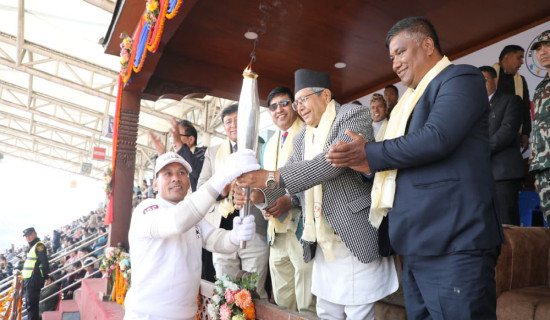- Saturday, 27 December 2025
Nepal Needs Dedicated Burn Centre
Burn injuries are a devastating yet often overlooked aspect of global healthcare. Every year, millions of people worldwide suffer from burns, resulting in significant morbidity, mortality, and long-term physical and psychological impacts. Despite these profound consequences, burn injuries remain a neglected public health issue in many parts of the world especially in the countries with limited resources. Nepal faces significant challenges in healthcare. Among these, the treatment of burn injuries stands out as an area of urgent need. Burns are a common yet severely underserved medical condition in Nepal, affecting thousands of people every year.
Nepal has no dedicated hospital for the treatment of burn injuries, a situation that must change for several compelling reasons. A plastic surgeon trained in burn revealed the fact that, at present, only 50 per cent of the patients with 40 per cent burns survives whereas with the dedicated burn hospital, within 5-10 years, the team can save 50 per cent of the patients with 60 per cent burns in the country. Burn injuries affect individuals of all ages and socioeconomic backgrounds, with children and vulnerable populations often bearing the brunt of the burden. In Nepal, burns are disturbingly common, particularly among women, children, and the elderly living in poverty.
Data suggests that the majority of burn injuries occur within the home, largely due to unsafe cooking practices, and inadequate housing conditions. In rural areas, where access to electricity is limited, the reliance on traditional stoves (chulo) and kerosene lamps exacerbates the risk of burns. These factors contribute to a high incidence of both thermal burns and scalds, particularly among young children who are often accidentally exposed to hot liquids.
Intervention
Women, especially those in rural and low-income households, are disproportionately affected by burn injuries in Nepal. Cultural practices, including the use of open flames for cooking and heating, place women at higher risk. Furthermore, there are reports of intentional burns related to domestic violence, where women are targeted as a form of abuse. This not only points to a public health issue but also a deeper societal problem that requires attention and intervention from both health professionals and policymakers. Additionally, the lack of proper safety measures in industrial settings and frequent electrical accidents further increase the incidence of burns. Yet, the existing healthcare infrastructure is ill-equipped to handle the unique challenges posed by these injuries.
Currently, burn victims must rely on general hospitals that lack specialised burn units and of course, lacks burn specialists. These hospitals often do not have the necessary equipment, trained staff, or resources to provide the comprehensive care that burn victims require. The absence of specialised burn care means that patients frequently receive suboptimal treatment, leading to higher mortality rates, prolonged suffering, and poor recovery outcomes. Although specialised burn unit in a hospital can be developed as it is just, largely, a onetime investment but we do not have sufficient numbers of plastic surgeons trained in burn treatment to manage the unit and for next 10-20 years, we wish not to have large number of burn patients needing several burn hospitals in a country with just 30 million population.
It is important to note that present facilities (two plastic surgery hospitals) in the capital have burn units but no ICU for an individual patient, which causes nosocomial infection, leading to high mortality. A dedicated burn hospital would not only address these gaps but also foster the development of expertise in burn care, which is currently lacking. Burn injuries place a significant economic and social burden on victims and their families. The cost of prolonged hospital stays, repeated surgeries, and ongoing rehabilitation can be overwhelming, particularly for those living in poverty. Moreover, the physical and emotional scars left by burns can lead to long-term disabilities, affecting the victims' quality of life and their ability to contribute to society.
Center for excellence
A dedicated burn centre would serve as a centre for training healthcare professionals in the latest burn care techniques. This is crucial in a country like Nepal, where medical professionals often lack opportunities for specialised training. Furthermore, such a facility could become a hub for research into burn injuries, leading to better prevention strategies, treatment protocols, and understanding of the social dynamics that contribute to burn risks. Establishing a dedicated burn centre would be a significant step towards improving the country's healthcare system. It would not only save lives but also signal a commitment to addressing the broader issues of healthcare equity and quality. It could serve as a model for other specialty hospitals.
The epidemiology of burns paints a grim picture of a preventable public health issue that continues to cause significant harm to the population, particularly among the most vulnerable. Addressing this crisis requires urgent and coordinated action from the government, healthcare providers, and communities. By prioritising burn prevention, improving access to care, and addressing the underlying social determinants of health, Nepal can significantly reduce the incidence and impact of burn injuries, ultimately improving the quality of life for its people.
(Prof. Dr. Lohani is the executive director at the Health Concern. lohanis@gmail.com)

















